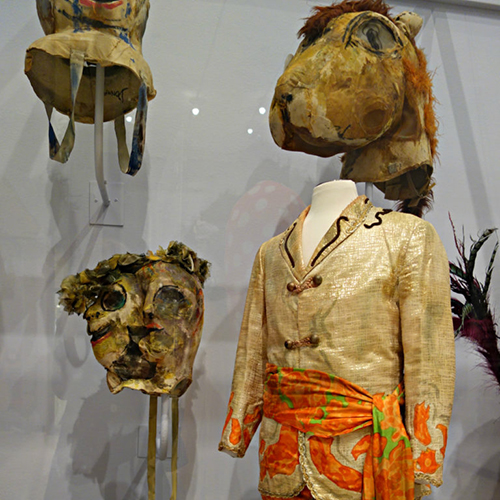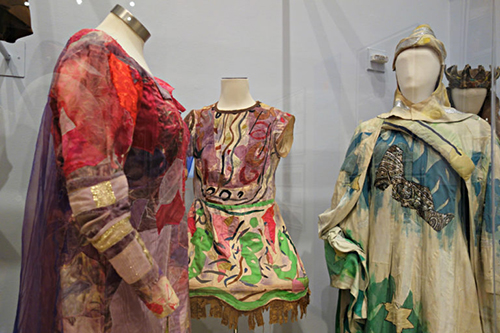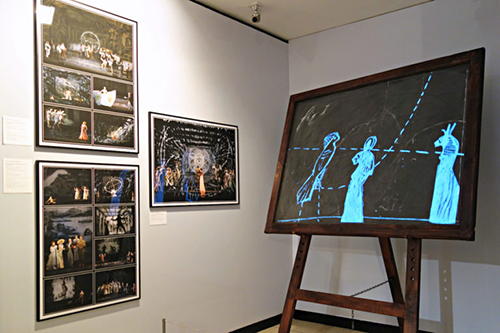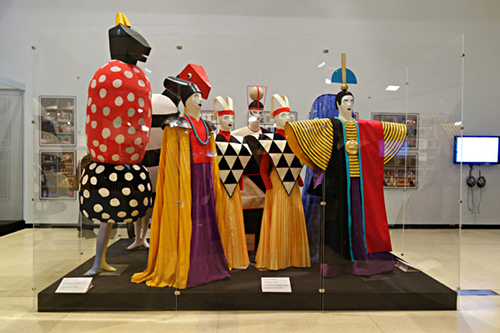Costumes and masks designed by Marc Chagall in 1966 for the Metropolitan Opera
Indeed, the spirited second aria of the Queen of the Night is one of the great soprano challenges, and the tale of Prince Tamino finding both love and idealism with the queen’s daughter Pamina endures as an accessible fantasy. Some artists were inspired to create elaborate technological spectacles, like Kentridge’s 2005 production at the Royal Belgian Opera House, which Levin calls the “most cerebral approach.” Set in the 19th century and evoking early photographic techniques, the staging featured Kentridge’s drawings projected on a chalkboard, as well as his charcoal-based animation. Others, like Chagall, were “responding primarily to the music,” Levin said. His 1966 brush-stroked costumes for the Metropolitan Opera, impressively intact and on view in one long exhibition case, have animalistic characters that seem to have prowled from one of his paintings.
Even in the 18th century, The Magic Flute was a phantasmagoric extravaganza. “The original theater, where the production premiered in 1791, it was a state-of-the-art theater,” Levin said. “It held 1,000 people, and it had every device known at the time. They had the trap doors, and machinery for fire, thunder, lighting, and waterfalls.”
Costumes and masks designed by Marc Chagall in 1966 for the Metropolitan Opera
According to Levin, most of the first audiences didn’t notice that Mozart was partly using his grand opera as “a vehicle to promote the agenda of Free Masons,” the fraternal society of which he was a member. Some of the artists worked this history into their productions, like Sendak, whose 1980 costumes included Sarastro’s followers dressed as Masons and a finale staged against an illustration of a Masonic Temple.
Many of the costumes on view at the New York Public Library are actually still in use. For example, the Metropolitan Opera is staging an adaptation with Julie Taymor’s designs this December. After the exhibition closes this August, it will open in September at Kent State University Museum.
“This is not a very easy exhibition to get together because of the timing of everything, but we can replace them with other productions every bit as deserving,” Levin explained.
Costumes by Achim Freyer for the 1997 Salzburg Festival
The great joy, then, of seeing the current exhibition, is it may be the only chance to witness these 18 productions at once. Sure, it’s not like seeing the full opera played out on the stage, but you can compare the glimmering wardrobes of the Queen of the Night, the unexpected influences like Hockney in 1991 borrowing the Metropolitan Museum of Art staircase for his Great Temple, and appreciate the incredible whimsy played out through costumes like Jun Kaneko’s colorful and geometric concoctions for the San Francisco Opera. Below, you can check out clips from some of the productions, paired with images of the costumes and set designs on view in Magical Designs for Mozart’s Magic Flute.
David Hockney (1977)
David Hockney’s 1977 set designs for the 1978 Glyndebourne Festival, later adapted for the Metropolitan Opera
Maurice Sendak (1981)
Houston Grand Opera
Set designs by Maurice Sendak from 1981
Gerald Scarfe (1993)
Los Angeles Opera
Costumes designed by Gerald Scarfe for a 1993 production directed by Peter Hall with the Los Angeles Opera
Julie Taymor (2004)
The Metropolitan Opera
Costumes designed by Julie Taymor in 2004 for the Metropolitan Opera
William Kentridge (2005)
Royal Belgian Opera House
Images of the William Kentridge’s 2005 production for the Royal Belgian Opera House in Brussels and Kentridge’s “Blackboard” installation and film for the opera
Jorge Jara (2006)
Salzburg Festival
Costume by Jorge Jara for the 2006 Salzburg Festival
Jun Kaneko (2013)
San Francisco Opera
Costumes designed by Jun Kaneko in 2013 for a San Francisco Opera production of ‘The Magic Flute,’ on view in ‘Magical Designs for Mozart’s Magic Flute’ at the New York Public Library for the Performing Arts, Dorothy and Lewis B. Cullman Center
Magical Designs for Mozart’s Magic Flute continues at the New York Public Library for the Performing Arts, Dorothy and Lewis B. Cullman Center (40 Lincoln Center Plaza, Upper West Side, Manhattan) through August 27.








